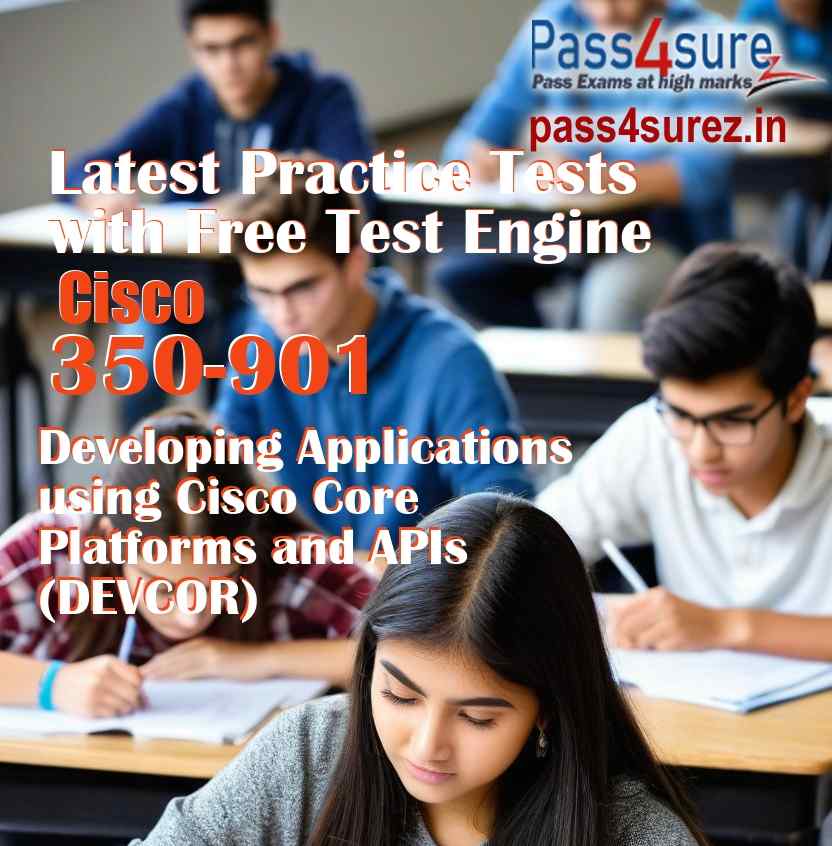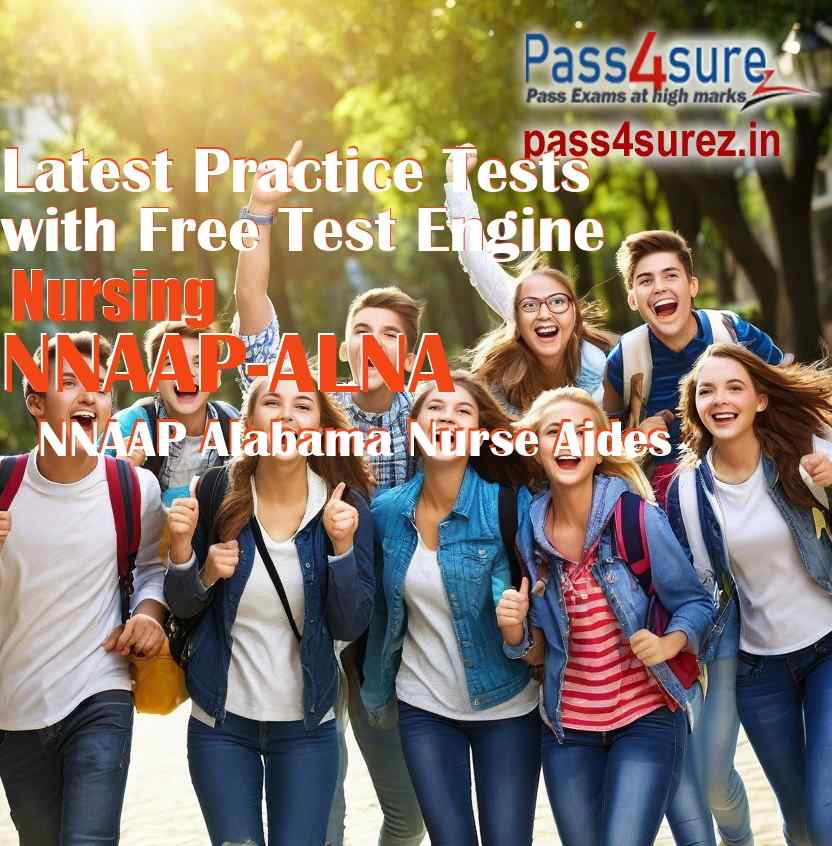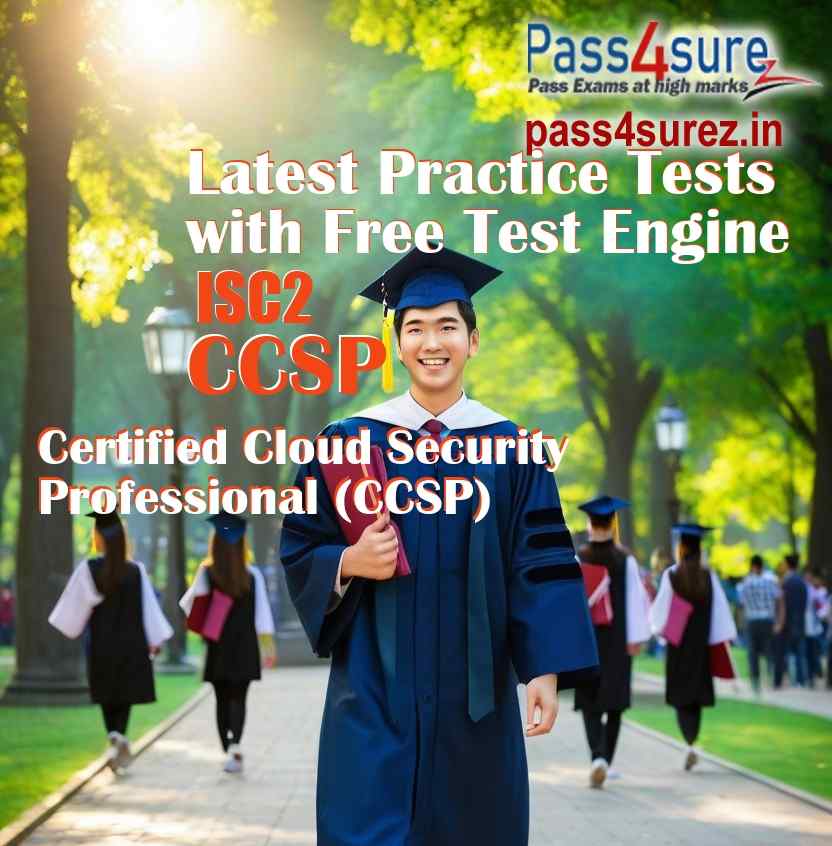| Exam Code | CCSP |
| Questions and Answers | 512 |
| Premium Access | Yes |
| Online Test Engine | Yes |
| Comprehensive Q&A | Yes |
| Success Rate | 98% |
| Real Questions | Yes |
| Updated Regularly | Yes |
| Portable Files | ✔ |
| Unlimited Download | ✔ |
| 100% Secured | ✔ |
| Confidentiality | 100% |
| Success Guarantee | 100% |
| Any Hidden Cost | $0.00 |
| Auto Recharge | No |
| Updates Intimation | by Email |
| Technical Support | Free |
| PDF Compatibility | Windows, Android, iOS, Linux |
| Test Engine Compatibility | Mac/Windows/Android/iOS/Linux |
| Sample Questions |  |
Pass4sure Practice Tests are an effective way to prepare for the CCSP exam. The practice tests include premium PDF and Test Engine Software. Pass4surez.in provides an extensive question bank to improve your knowledge and help you achieve high marks on the CCSP exam.
The Certified Cloud Security Professional (CCSP) exam questions and answers on Pass4surez.in are regularly verified and updated to ensure they reflect the latest syllabus and topics covered in the real test. The certification exams and entry test exams from pass4surez.com make you familiar with the test environment. The goal is to enhance your knowledge of the CCSP exam and enable you to pass it on your first attempt.
The PDF of CCSP exam questions and answers provided by Pass4surez.in contains a comprehensive pool of questions and verified answers, including references and explanations where applicable. The objective is not only to help you pass the exam, but also to significantly improve your knowledge of the latest CCSP course topics.
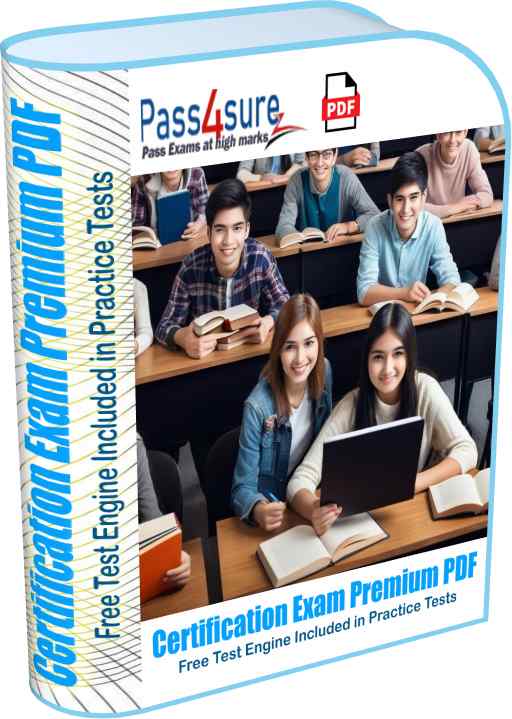 |
|
CERTIFICATION EXAM PREMIUM PDF
Pass4Sure provide premium PDF that contains all the questions and answers that are necessary to make your concepts about the exam topics clear and boost your knowledge about the exam. These questions and answers make you ready to face actual test in test centers. Our team keep on revising material and update the exam questions accordingly. You will feel confident in test center. Our support team keep on helping our customers to make their testing experience best. Our premium PDF files are searchable, convertable and printable at high quality to make book that you can study during traveling or during vacations. Our automated system sends intimation email to our customers on each update. The files in customer download section is overwritten with latest pdf files.
|
| |
|
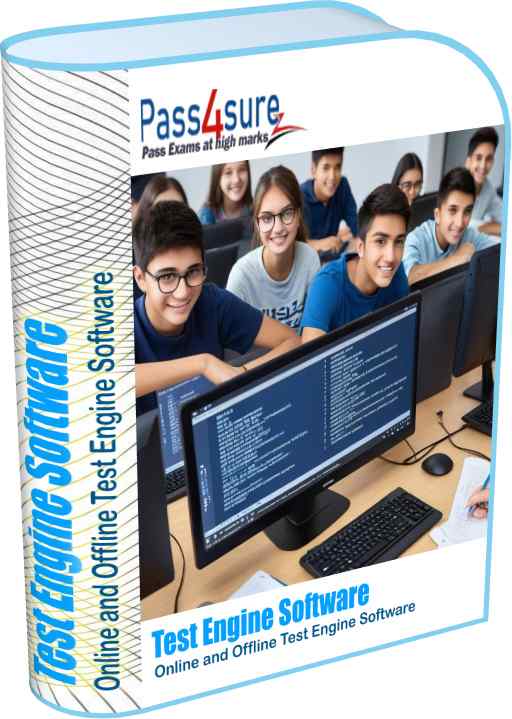 |
|
CERTIFICATION EXAM TEST ENGINE
Pass4sure test engine is best certification and examination preparation tool that help you make yourself ready to take the actual exam and get high marks in the exam. Our OTE (Online Test Engine) support all OS Platforms including iOS, Android, Windows, Linux, Chromebook etc and provide up to date experience to get ready for actual test. Our Offline Test Engine is compatible to all windows platforms including latest windows versions. Our test engines helps to familiarize actual test environment and makes you ready to take timed tests. Your performance history and graphs helps you to see when you are ready to sit in actual exam in test center. These test engines uses up to date and latest questions and answers, keeps on updating the questions pool and sends you intimation on each update.
|
Pass4sure Premium PDF and Test Engines support all platforms and devices including mobile devices and computers. You should download sample PDF and Test Engine to evaluate the product before you buy the full version. Our exam samples include some questions that may be or may not be up to date but full version is always up to date.
CCSP Examination Information
Exam Duration : 3 hours
Number of questions : 125
Format : Multiple Choice
Passing scores : 700 out of 1000 points
Exam availability : English
Testing center : Pearson VUE Testing Center
About CCSP
(ISC) and the Cloud Security Alliance (CSA) developed the Certified Cloud Security Professional (CCSP)
credential to ensure that cloud security professionals have the required knowledge, skills, and abilities in
cloud security design, implementation, architecture, operations, controls, and compliance with regulatory
frameworks. A CCSP applies information security expertise to a cloud computing environment and
demonstrates competence in cloud security architecture, design, operations, and service orchestration. This
professional competence is measured against a globally recognized body of knowledge. The CCSP is a standalone credential that complements and builds upon existing credentials and educational programs, including
(ISC)s Certified Information Systems Security Professional (CISSP) and CSAs Certificate of Cloud Security
Knowledge (CCSK).
The topics included in the CCSP Common Body of Knowledge (CBK) ensure its relevancy across all disciplines
in the field of cloud security. Successful candidates are competent in the following 6 domains:
• Cloud Concepts, Architecture and Design
• Cloud Data Security
• Cloud Platform & Infrastructure Security
• Cloud Application Security
• Cloud Security Operations
• Legal, Risk and Compliance
Domains Weight
1. Cloud Concepts, Architecture and Design 17%
2. Cloud Data Security 19%
3. Cloud Platform & Infrastructure Security 17%
4. Cloud Application Security 17%
5. Cloud Security Operations 17%
6. Legal, Risk and Compliance 13%
Total: 100%
Domain 1:
Cloud Concepts, Architecture and Design
1.1 Understand Cloud Computing Concepts
» Cloud Computing Definitions
» Cloud Computing Roles (e.g., cloud service customer, cloud service provider, cloud service partner, cloud service broker)
» Key Cloud Computing Characteristics (e.g., on-demand self-service, broad network access, multi-tenancy,
rapid elasticity and scalability, resource pooling, measured service)
» Building Block Technologies (e.g., virtualization, storage, networking, databases, orchestration)
1.2 Describe Cloud Reference Architecture
1.3 Understand Security Concepts Relevant to Cloud Computing
1.4 Understand Design Principles of Secure Cloud Computing
» Cloud Secure Data Lifecycle
» Cloud based Disaster Recovery (DR) and Business Continuity (BC) planning
» Cost Benefit Analysis
» Functional Security Requirements (e.g., portability, interoperability, vendor lock-in)
» Security Considerations for Different Cloud Categories (e.g., Software as a Service (SaaS), Infrastructure as a
Service (IaaS), Platform as a Service (PaaS))
1.5 Evaluate Cloud Service Providers
» Verification Against Criteria (e.g., International Organization for Standardization/International
Electrotechnical Commission (ISO/IEC) 27017, Payment Card Industry Data Security Standard (PCI DSS))
» System/subsystem Product Certifications (e.g., Common Criteria (CC), Federal Information Processing
Standard (FIPS) 140-2)
» Cloud Computing Activities
» Cloud Service Capabilities (e.g., application
capability types, platform capability types,
infrastructure capability types)
» Cloud Service Categories (e.g., Software as a
Service (SaaS), Infrastructure as a Service (IaaS),
Platform as a Service (PaaS))
» Cloud Deployment Models (e.g., public, private,
hybrid, community)
» Cloud Shared Considerations (e.g.,
interoperability, portability, reversibility,
availability, security, privacy, resiliency,
performance, governance, maintenance and
versioning, service levels and Service Level
Agreements (SLA), auditability, regulatory)
» Impact of Related Technologies (e.g., machine
learning, artificial intelligence, blockchain,
Internet of Things (IoT), containers, quantum
computing)
» Cryptography and Key Management
» Access Control
» Data and Media Sanitization (e.g., overwriting,
cryptographic erase)
» Network Security (e.g., network security groups)
» Virtualization Security (e.g., hypervisor security,
container security)
» Common Threats
2.1 Describe Cloud Data Concepts
» Cloud Data Life Cycle Phases
» Data Dispersion
2.2 Design and Implement Cloud Data Storage Architectures
» Storage Types (e.g. long term, ephemeral, raw-disk)
» Threats to Storage Types
2.3 Design and Apply Data Security Technologies and Strategies
2.4 Implement Data Discovery
» Structured Data
» Unstructured Data
2.5 Implement Data Classification
» Mapping
» Labeling
» Sensitive data (e.g., Protected Health Information (PHI), Personally Identifiable Information (PII),
card holder data)
2.6 Design and Implement Information Rights Management (IRM)
» Objectives (e.g., data rights, provisioning, access models)
» Appropriate Tools (e.g., issuing and revocation of certificates)
Domain 2:
Cloud Data Security
» Encryption and Key Management
» Hashing
» Masking
» Tokenization
» Data Loss Prevention (DLP)
» Data Obfuscation
» Data De-identification (e.g., anonymization)
2.7 Plan and Implement Data Retention, Deletion and Archiving Policies
» Data Retention Policies
» Data Deletion Procedures and Mechanisms
» Data Archiving Procedures and Mechanisms
» Legal Hold
2.8 Design and Implement Auditability, Traceability and Accountability of Data Events
» Definition of Event Sources and Requirement of Identity Attribution
» Logging, Storage and Analysis of Data Events
» Chain of Custody and Non-repudiation
Comprehend Cloud Infrastructure Components
3.2 Design a Secure Data Center
» Logical Design (e.g., tenant partitioning, access control)
» Physical Design (e.g. location, buy or build)
» Environmental Design (e.g., Heating, Ventilation and Air Conditioning (HVAC), multi-vendor pathway
connectivity)
3.3 Analyze Risks Associated with Cloud Infrastructure
3.4 Design and Plan Security Controls
3.5 Plan Disaster Recovery (DR) and Business Continuity (BC)
Domain 3:
Cloud Platform and Infrastructure
Security
» Physical Environment
» Network and Communications
» Compute
» Virtualization
» Storage
» Management Plane
» Risk Assessment and Analysis
» Cloud Vulnerabilities, Threats and
Attacks
» Virtualization Risks
» Counter-measure Strategies
» Physical and Environmental Protection (e.g.,
on-premise)
» System and Communication Protection
» Virtualization Systems Protection
» Identification, Authentication and Authorization
in Cloud Infrastructure
» Audit Mechanisms (e.g., log collection, packet
capture)
» Risks Related to the Cloud Environment
» Business Requirements (e.g., Recovery
Time Objective (RTO), Recovery Point
Objective (RPO), Recovery Service Level
(RSL))
» Business Continuity/Disaster Recovery
Strategy
» Creation, Implementation and Testing
of Plan
4.1 Advocate Training and Awareness for Application Security
» Cloud Development Basics
» Common Pitfalls
» Common Cloud Vulnerabilities
4.2 Describe the Secure Software Development Life Cycle (SDLC) Process
» Business Requirements
» Phases and Methodologies
4.3 Apply the Secure Software Development Life Cycle (SDLC)
4.4 Apply Cloud Software Assurance and Validation
» Functional Testing
» Security Testing Methodologies
4.5 Use Verified Secure Software
» Approved Application Programming Interfaces (API)
» Supply-chain Management
» Third Party Software Management
» Validated Open Source Software
» Avoid Common Vulnerabilities During
Development
» Cloud-specific Risks
» Quality Assurance
» Threat Modeling
» Software Configuration Management and
Versioning
4.6 Comprehend the Specifics of Cloud Application Architecture
» Supplemental Security components (e.g., Web Application Firewall (WAF), Database Activity Monitoring
(DAM), Extensible Markup Language (XML) firewalls, Application Programming Interface (API) gateway)
» Cryptography
» Sandboxing
» Application Virtualization and Orchestration
4.7 Design Appropriate Identity and Access Management (IAM) Solutions
» Federated Identity
» Identity Providers
» Single Sign-On (SSO)
» Multi-factor Authentication
» Cloud Access Security Broker (CASB)
5.1 Implement and Build Physical and Logical Infrastructure for Cloud Environment
» Hardware Specific Security Configuration Requirements (e.g., Basic Input Output System (BIOS), settings for
virtualization and Trusted Platform Module (TPM), storage controllers, network controllers)
» Installation and Configuration of Virtualization Management Tools
» Virtual Hardware Specific Security Configuration Requirements (e.g., network, storage, memory, Central
Processing Unit (CPU))
» Installation of Guest Operating System (OS) Virtualization Toolsets
5.2 Operate Physical and Logical Infrastructure for Cloud Environment
5.3 Manage Physical and Logical Infrastructure for Cloud Environment
Domain 5:
Cloud Security Operations
» Access Controls for Remote Access (e.g., Remote
Desktop Protocol (RDP), Secure Terminal Access,
Secure Shell (SSH))
» Operating System (OS) Baseline Compliance
Monitoring and Remediation
» Patch Management
» Performance and Capacity Monitoring (e.g.,
network, compute, storage, response time)
» Hardware Monitoring (e.g., Disk, Central
Processing Unit (CPU), fan speed, temperature)
» Configuration of Host and Guest Operating
System (OS) Backup and Restore Functions
» Network Security Controls (e.g., firewalls,
Intrusion Detection Systems (IDS), Intrusion
Prevention Systems (IPS), honeypots,
vulnerability assessments, network security
groups)
» Management Plane (e.g., scheduling,
orchestration, maintenance)
» Configure Access Control for Local and Remote
Access (e.g., Secure Keyboard Video Mouse
(KVM), console-based access mechanisms,
Remote Desktop Protocol (RDP))
» Secure Network Configuration (e.g., Virtual Local
Area Networks (VLAN), Transport Layer Security
(TLS), Dynamic Host Configuration Protocol
(DHCP), Domain Name System (DNS), Virtual
Private Network (VPN))
» Operating System (OS) Hardening Through the
Application of Baselines (e.g., Windows, Linux,
VMware)
» Availability of Stand-Alone Hosts
» Availability of Clustered Hosts (e.g., Distributed
Resource Scheduling (DRS), Dynamic
Optimization (DO), storage clusters, maintenance
mode, High Availability)
» Availability of Guest Operating System (OS)
5.4 Implement Operational Controls and Standards (e.g., Information Technology
Infrastructure Library (ITIL), International Organization for Standardization/International
Electrotechnical Commission (ISO/IEC) 20000-1)
Change Management
» Continuity Management
» Information Security Management
» Continual Service Improvement Management
» Incident Management
» Problem Management
» Release Management
» Deployment Management
» Configuration Management
» Service level Management
» Availability Management
» Capacity Management
Support Digital Forensics
» Forensic Data Collection Methodologies
» Evidence Management
» Collect, Acquire and Preserve Digital Evidence
Manage Communication with Relevant Parties
Vendors
» Customers
» Partners
» Regulators
» Other Stakeholders
5.4 Implement Operational Controls and Standards (e.g., Information Technology
Infrastructure Library (ITIL), International Organization for Standardization/International
Electrotechnical Commission (ISO/IEC) 20000-1)
5.5 Support Digital Forensics
» Forensic Data Collection Methodologies
» Evidence Management
» Collect, Acquire and Preserve Digital Evidence
5.6 Manage Communication with Relevant Parties
5.7 Manage Security Operations
» Security Operations Center (SOC)
» Monitoring of Security Controls (e.g.,
firewalls, Intrusion Detection Systems (IDS),
Intrusion Prevention Systems (IPS), honeypots,
vulnerability assessments, network security
groups)
» Log Capture and Analysis (e.g., Security
Information and Event Management (SIEM), log
management)
» Incident Management
Articulate Legal Requirements and Unique Risks within the Cloud Environment
6.2 Understand Privacy Issues
» Difference Between Contractual and Regulated Private Data (e.g., Protected Health Information (PHI),
Personally Identifiable Information (PII))
» Country-Specific Legislation Related to Private Data (e.g., Protected Health Information (PHI), Personally
Identifiable Information (PII))
» Jurisdictional Differences in Data Privacy
» Standard Privacy Requirements (e.g., International Organization for Standardization/International
Electrotechnical Commission (ISO/IEC) 27018, Generally Accepted Privacy Principles (GAPP), General Data
Protection Regulation (GDPR))
6.3 Understand Audit Process, Methodologies, and Required Adaptations for a
Cloud Environment
Domain 6:
Legal, Risk and Compliance
» Conflicting International Legislation
» Evaluation of Legal Risks Specific to Cloud
Computing
» Legal Framework and Guidelines
» eDiscovery (e.g., International Organization
for Standardization/International
Electrotechnical Commission (ISO/IEC) 27050,
Cloud Security Alliance (CSA) Guidance)
» Forensics Requirements
Internal and External Audit Controls
» Impact of Audit Requirements
» Identify Assurance Challenges of Virtualization
and Cloud
» Types of Audit Reports (e.g., Statement
on Standards for Attestation Engagements
(SSAE), Service Organization Control
(SOC), International Standard on Assurance
Engagements (ISAE))
» Restrictions of Audit Scope Statements (e.g.,
Statement on Standards for Attestation
Engagements (SSAE), International Standard on
Assurance Engagements (ISAE))
» Gap Analysis
» Audit Planning
» Internal Information Security Management
System (ISMS)
» Internal Information Security Controls System
» Policies (e.g., organizational, functional, cloud
computing)
» Identification and Involvement of Relevant
Stakeholders
» Specialized Compliance Requirements for
Highly-Regulated Industries (e.g., North
American Electric Reliability Corporation/
Critical Infrastructure Protection (NERC/CIP),
Health Insurance Portability and Accountability
Act (HIPAA), Payment Card Industry (PCI))
» Impact of Distributed Information Technology
(IT) Model (e.g., diverse geographical locations
and crossing over legal jurisdictions)
Understand Implications of Cloud to Enterprise Risk Management
6.5 Understand Outsourcing and Cloud Contract Design
» Business Requirements (e.g., Service Level Agreement (SLA), Master Service Agreement (MSA), Statement
of Work (SOW))
» Vendor Management
» Contract Management (e.g., right to audit, metrics, definitions, termination, litigation, assurance,
compliance, access to cloud/data, cyber risk insurance)
» Supply-Chain Management (e.g., International Organization for Standardization/International
Electrotechnical Commission (ISO/IEC) 27036)
» Assess Providers Risk Management Programs
(e.g., controls, methodologies, policies)
» Difference Between Data Owner/Controller vs.
Data Custodian/Processor (e.g., risk profile, risk
appetite, responsibility)
» Regulatory Transparency Requirements (e.g.,
breach notification, Sarbanes-Oxley (SOX),
General Data Protection Regulation (GDPR))
» Risk Treatment (i.e., avoid, modify, share, retain)
» Different Risk Frameworks
» Metrics for Risk Management
» Assessment of Risk Environment (e.g., service,
vendor, infrastructure)
You can download a free PDF of the CCSP practice test and study guide to try before purchasing the premium files. To ace the exam, simply download the CCSP exam questions and answers file, memorize the content, and practice with the VCE Exam Simulator. This will ensure you are fully prepared for the real test.
The CCSP PDF practice test and exam questions and answers can be accessed on any device, including iPhone, iPad, Android, and Windows. You can download the PDF to your computer or any other device and start studying. Additionally, you can download and install the VCE Exam Simulator for further practice. The CCSP PDF is printable in high quality, allowing you to take it with you on vacations or while traveling. Your updated CCSP exam files can be accessed anytime from your online account, and you will receive your login credentials immediately after purchase.
